Edition XS (2023)
back to HIFIMAN
back to measurements
home
published: June-04-2023
NO SMOOTHING is applied to the shown plots. Most measurement sites have some smoothing applied which ‘irons flat’ sharp peaks and ‘wiggles’. I do not use smoothing because some info about sound quality is lost when plots are smoothed.
Aside from a small correction of the microphone itself also some correction in the lowest frequencies is applied to the plots to compensate for the perceived loss of bass when using headphones. This is described HERE in more detail.
A ‘horizontal‘ frequency response curve on the shown frequency response plots on this website thus indicates a perceived ‘flat’ tonal signature.
ALL measurements are made with a good SEAL on a flatbed measurement rig.
The shape of your head, bone structure, pad size, pad ‘softness, (compliance), hair or no hair and or wearing glasses may (drastically) change the frequency response of some headphones, so… your personal experience may differ substantially from these plots.
Frequency response (tonal balance) is the most sound-determining aspect of headphones. A horizontal line shows audible neutral response in the plots on this website. Deviations in different severity at different frequency bands have an effect on the sound character.
The bigger the deviation the stronger the effect.
Below an aid to help determining the sound character of headphones with relation to the frequency response.

HIFIMAN Edition XS (2023)
 The HIFIMAN Edition XS is a semi-open planar magnetic over-ear headphone intended to be driven directly from desktop gear and the better portable DAPs as well. They can be connected directly to a phone and it will play nicely.
The HIFIMAN Edition XS is a semi-open planar magnetic over-ear headphone intended to be driven directly from desktop gear and the better portable DAPs as well. They can be connected directly to a phone and it will play nicely.
It retails for around € 550.- which is not really cheap but competitive with most other planar magnetic headphones. The Edition XS was launched early 2022 and was € 550,- and replaces the Edition X v2.
The headband can extend 35mm (clicking sliders) and can be pulled apart quite a distance (200mm). Padding is firm regular foam covered with pleather. This may start to flake after a few years of usage.
Depending on the size of one’s head there may be some pressure on the upper sides of the head instead of on top of the head.
The pads are comfortable and there is plenty of room for the ears. The pads are huge in size 140mm high and 100mm wide and have a depth of around 24mm. The outside is pleather but the part that touches the skin is made of fabric. The pads are angled (only 6 degrees) o it is important to look at the L and R markings on the inside of the headband.
Alas, when wearing glasses you may hear squeaky sounds when moving the head or headphone that are so loud they become distracting. No such issues when not wearing glasses.
As the pads are rather large and the foam inside is firm getting a perfect seal may be difficult for some.
This is a semi-open headphone despite being very open on the back side of the driver. The fact that the space between the driver and ear/head is ‘closed’ (as in not leaking deliberately) is what makes headphones like these semi-open. A headphone like the HD800 and DT990 for instance are fully open.
The supplied cable has a silicone feel to it and is smooth feeling. The good news is that the cable is not annoyingly microphonic. The 1.45mm cable have L and R markings on the 3.5mm TRS plugs on the headphone side. Only the Tip and Sleeve of the straight TRS jack plugs are connected which makes it important to plug these connectors in the correct cups. The connector sockets are positioned so the cable drapes a bit in front of you and not towards the shoulders.
The sensitivity is not very high but high enough so it can be driven reasonable loud directly from a phone/tablet/PC. It does have a rather low impedance, or should I say resistance of 14Ω (measured). This means if you want to play impressively loud or EQ the bass up you will need a desktop amp capable of delivering 3V (0.6W) in 16Ω.
It is an open headphone and there is absolutely no isolation from outside noises. Everyone around you thus also can hear what you are playing.
This headphone was kindly sent to me by a reader that wanted it measured/reviewed.
specifications:
Type: Over ear, semi-open
Usage: Home usage
Driver type: planar magnetic
Pads: replaceable, 6 degree angled hybrid pleather/polyester cloth
Inner pad dimensions: depth front: 28mm rear, 25mm rear side, height: 85mm, width: 50mm
Collapsible: No.
Headphone connector: 3.5mm TRS (marked L and R)
Cable entry: double sided
Cable: replaceable, 1.45m with an angled gold-plated 3.5mm TRS plug with 6.3mm adapter
Driver size: 90 x 60mm
Nom. power rating: not specified (assumed 2W)
Max. voltage: 5.5Vrms (15Vpp)
Max. current: 400mA
Max. S.P.L. 126dB (assumed 2W)
Impedance: 14Ω (measured)
Efficiency: 91dB @ 1mW
Sensitivity: 109dB @ 1V
Weight: 422g.
Clamping force: low/medium 4N.
Accessories: 1.45m. cable with angled gold-plated3.5mm TRS jack and push-on 6.3mm adapter, headphone stand (foam from the packaging).
Sound description:
The Edition XS has a full and ‘open’ dynamic sound with an overly sharp treble.
The bass does sound good and is well extended but not elevated.
The mids sound good and sound dynamic and realistic. There is a some sharpness heard with some recordings on voices and instruments and cymbals are accentuated.
The treble sounds a bit elevated but is of fairly good quality. A passive in-line filter is available that addresses the elevated treble and makes the treble sound smoother and not ‘sharpish’. Parametric EQ also works and one can EQ in some more bass. This headphone reacts very well to EQ.
measurements:
Below the frequency response of the Edition XS (Left, Right)
Channel matching is excellent, as it is often with HIFIMAN headphones. Subbass response is excellent and goes down well below 20Hz.
The dip between 1kHz and 5kHz is smaller in reality than how it measures because of the so-called concha gain. This is because the drivers are angled (only 6 degrees) and thus makes slightly more use of the concha which ‘boosts’ certain frequencies that arrive under an angle.
A small dip in this part of the frequency range is more desirable than a peak and is associated with an improved sense of depth.
Treble extension is good, above 20kHz there still is some life just not at the same level. Ignore the sharp dips above 10kHz which are measurement artifacts and are only visible (not audible) because no smoothing is applied to this plot.
Around 7kHz there is a peak which is audible as ‘sibilance’ (brightness) to instruments and voices. There is also a second peak at around 12kHz which is responsible for the sharpness heard in cymbals etc. When you want to get rid of this you can use a passive inline filter or use parametric EQ.
Seal
Loss of seal with closed headphones usually means a substantial loss of bass. With open headphones this is less of an issue. The pads are shaped to conform to the head and ensures a decent seal in most cases. Below the effect when used with perfect seal, with thin arm glasses, thick arm glasses and with thick arm glasses that do not rest against the skin. 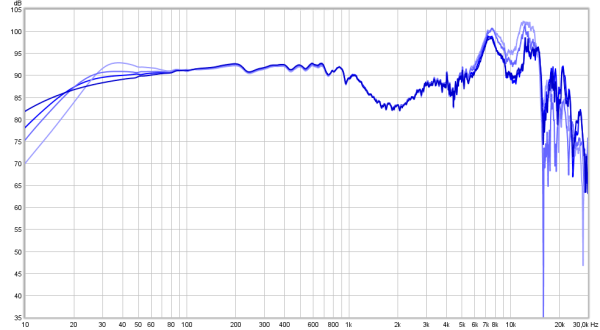
What is interesting is that a seal breach does reduce the subbass extension but low bass levels actually increase slightly. No real need to worry about needing a perfect seal for what concerns the bass. More interesting is what happens in the upper treble. A breaking of the seal increases the already elevated treble and makes the sound a bit sharper. People wearing glasses that do not rest against the skin at the point the pads make contact with the skin, and thus create a leak of seal, might be hearing ‘sharper’ (not brighter) sound than people that are able to get a good seal.
A small seal leakage has no audible consequences though.
comparisons
Comparisons with other headphones one may be familiar with can help to determine how it will sound. The plots are all smoothed considerably so the tonal character (balance) differences are easier to see. Note that differences of a few dB over a narrower band are already audible.
Below the Edition XS compared to some other HIFIMAN headphones, The Edition X, Edition XX, HE1000 and Ananda all have a similar sized and shaped driver/pads.
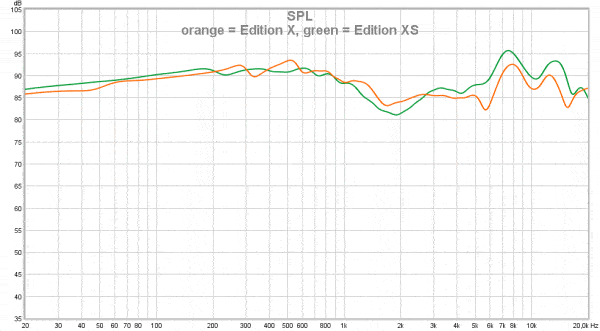 As can be seen the differences between HIFIMAN models aren’t really big.
As can be seen the differences between HIFIMAN models aren’t really big.
The biggest differences are in the 3-15kHz range. The less peaks and dips the better the treble quality is.
Below the differences between the Edition XS and some other open headphones with a known good sound quality.

The differences in tonal balance between HIFIMAN and other headphones are bigger than between the various models of the same brand.
output resistance / damping-factor
As this is a planar magnetic headphone its impedance is as good as ruler flat so a higher output resistance amplifier will have no consequences for the frequency response/tonal balance/damping. Driven with an amplifier with (0.2Ω) and (120Ω) output resistance.
Of course the levels are compensated, because a high output resistance reduces the overall level due to voltage division. For 120Ω this is –19.5dB .
The good news here is that the output impedance of the music source is completely irrelevant.
No tonal balance changes with different output resistances.
Below the phase response for the Edition XS. (Left, Right)
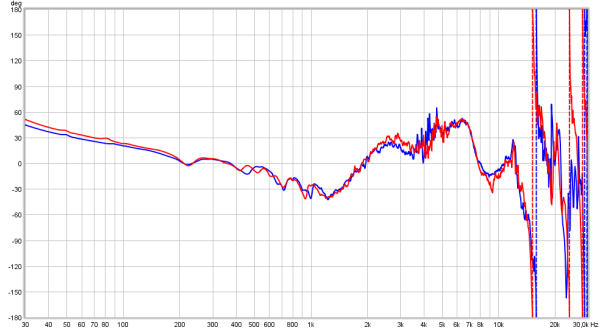 Slow phase shifts over a small frequency band are not audible. Sharp substantial changes in a narrow frequency band may well be audible. The steep change around 12kHz is coinciding with a resonance which is audible. Well… at least the resonance peak is audible, the phase shift probably isn’t contributing to the audibility of this.
Slow phase shifts over a small frequency band are not audible. Sharp substantial changes in a narrow frequency band may well be audible. The steep change around 12kHz is coinciding with a resonance which is audible. Well… at least the resonance peak is audible, the phase shift probably isn’t contributing to the audibility of this.
Below the distortion measurements of the Edition XS (Left channel).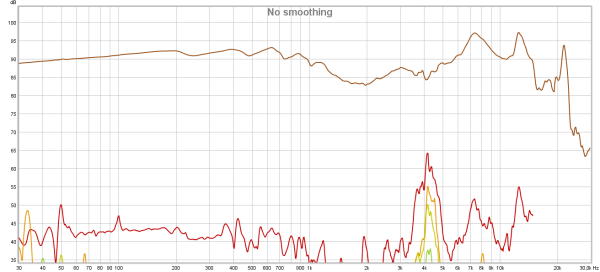
Below the same distortion plot but displayed in percentages.
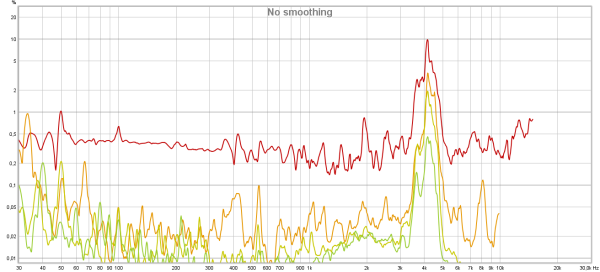
The left channel also had increased distortion in the same frequency area but not same in shape and severity. Below the left channel.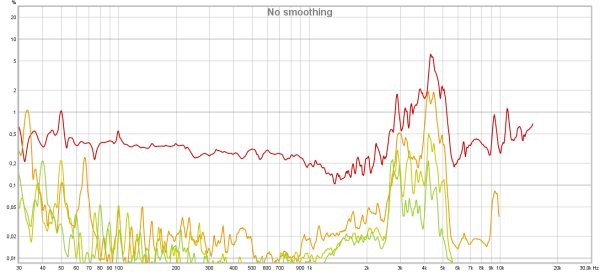
There is a rise in distortion in both channels around 4kHz. This happens to be a part of the frequency range where the hearing is most sensitive. The distortion reaches over 5% which are potentially audible levels. At lower listening levels (normal listening levels are not reaching 90dB SPL at 4kHz) the distortion is lower. The higher distortion is indicative of a driver (resonance) issue though.
Note: the 2nd harmonic distortion is most likely much lower than the 0.2% shown in the plots. This is due to the limit of the measurement rig which being reached.
Linearity
While there was no reason to suspect linearity issues the Edition XS is measured 5 times at different SPL. Once at 60dB, 70dB, 80dB, 90dB and 95dB SPL. When the traces are overlaid and have the same shape then there is no compression. 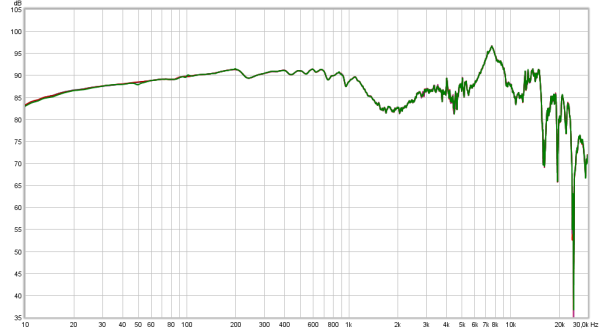 The 70dB, 80dB, 90dB and 95dB traces are hiding behind the 60dB trace so there is no indication of any compression going on till at least 95dB SPL. Excellent !
The 70dB, 80dB, 90dB and 95dB traces are hiding behind the 60dB trace so there is no indication of any compression going on till at least 95dB SPL. Excellent !
Below the CSD of the Edition XS. (Left and Right are overlaid)
The CSD above is made in the same scale as the other plots on this website.
For comparison below the CSD of the similar price range HD660S2.
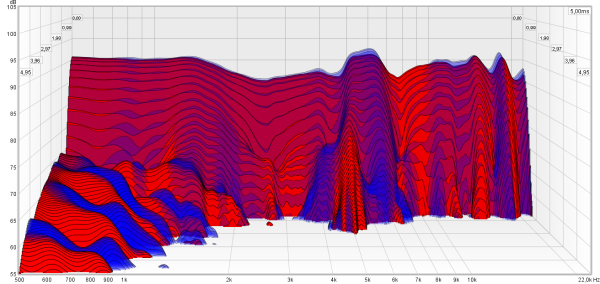 The Edition XS membrane isn’t nearly as well damped as the HD660S2.
The Edition XS membrane isn’t nearly as well damped as the HD660S2.
Below the CSD but not with the usual 5ms scale but 15ms range (right channel only)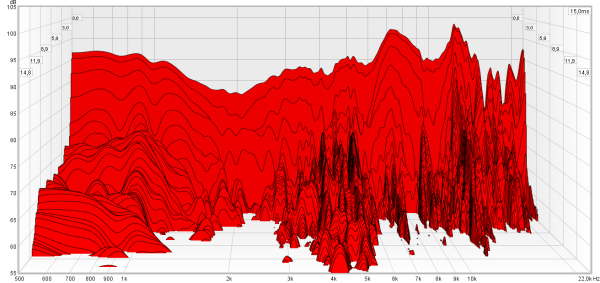 The resonances around 4.5kHz and 12kHz are clearly visible and last much longer than desirable.
The resonances around 4.5kHz and 12kHz are clearly visible and last much longer than desirable.
This is due to the very large and thin membrane which is hardly damped on both sides.
Most of the larger HIFIMAN headphones show similar damping issues.
Below the spectrum plot of the Edition XS (Right channel).
The not so well damped driver is easily spotted. Especially the 4kHz and >12kHz range is obvious.
The step response of the Edition XS is shown below (Left, Right) The rising edge reaches the desired levels but there is a lot of ringing going on the first 250μs.|
The rising edge reaches the desired levels but there is a lot of ringing going on the first 250μs.|
Also the HF ringing is still visible over the first 5ms.
Tonality is good, the emphasis around 400μs is indicative of the brightness. The slow drop of the horizontal part of the trace shows the excellent subbass extension.
9kHz filter
To get rid of the treble peak (when it bothers you otherwise you need not bother) you can use the circuit below or buy one ready made.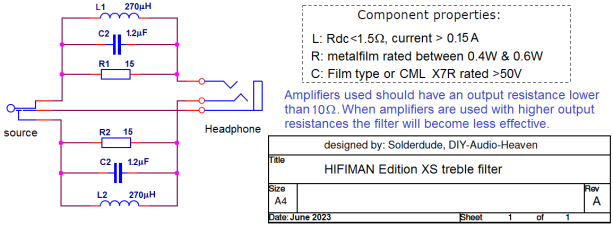
Below the effect of the filter is shown (right channel only) versus stock. Only the sharpness is removed/lowered. The rest of the sound remains as it is.
Only the sharpness is removed/lowered. The rest of the sound remains as it is.
Of course one can also use parametric EQ and address both the 7.5kHz and 12kHz peak only and add some lower bass.
While the frequency response improves (and thus tonality) the resonances and distortion will not be lowered.
Below the frequency response of the Edition XS with the described filter (left, right)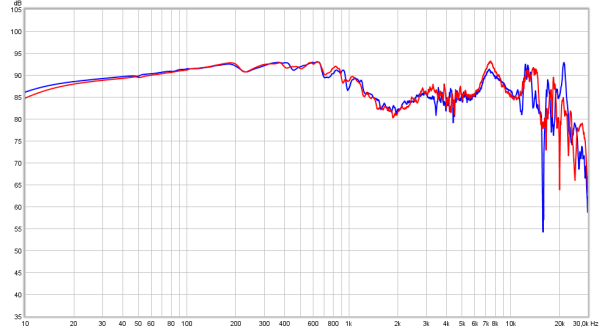 The overall treble level has been lowered while not affecting the treble extension.
The overall treble level has been lowered while not affecting the treble extension.
The 4.5kHz and 12kHz treble peaks are still there but now at a more pleasant level making the headphone less sharp. Treble quality, because of this is increased but still not ‘silky smooth’.
summary
Finish, build quality, comfort, weight (for a planar) of the Edition XS is decent to good. It is easy to get a decent fit on the head but given the large range the headphone can be positioned in this may lead to some seal leakage.
The pads can create a squeaky sound when in contact with glasses which may annoy some owners.
The rather high weight, which is not distributed well on the head, may be a downside for some.
The Edition XS is sensitive enough to be driven fairly loud directly from a phone/tablet/PC but a small decent headphone amp that can deliver 0.5W to 1W in 16Ω is recommended.
The 1.45m long cable with an angled 3.5mm TRS jack works fine for portable and desktop duties but may be a bit short for other circumstances. Fortunately the cable is easily replaced with something else because of the used standard 3.5mm connectors in the headphone.
The sound signature is ‘neutral’ as in not ‘warm/full bodied’ but not lacking in bass extension. Deep notes can be heard easily, just not as loud as some people might want. Those looking for ‘Harman type bass’ may want to look elsewhere when the EQ/tone control is not an option.
This headphone reacts great to EQ so it is easy to use tone control or EQ to add some bass.
The Edition XS is a bit sharp in the upper treble and can sound a bit sibilant on some recordings.
With classical music this is not a very big issues but brighter recordings sound a bit too ‘etched’/’hyper detailed’.
EQ (or the filter) helps and the treble sounds smoother yet still extended.
For those looking for a clear and (hyper) detailed sound without boosted lows and want ‘planar’ sound this headphone can be a good choice.
The Edition XS sounds somewhat ‘better’ than the Sundara. The Ananda is positioned just above the Edition XS.
In the € 500 to € 600 price range there is a lot of competition but the Edition XS definitely is a contender in this price class.
Alternatives are:
Meze 109Pro, FiiO FT3, OLLO Audio S5X, DT900 ProX, DT1990 Pro, HD660S2, Sundara, Ananda, HE6SE, Arya, ATH-R70X, MDR-MV1, NAN-6, NDH-30, Ether Flow, SRH-1840, HD650
